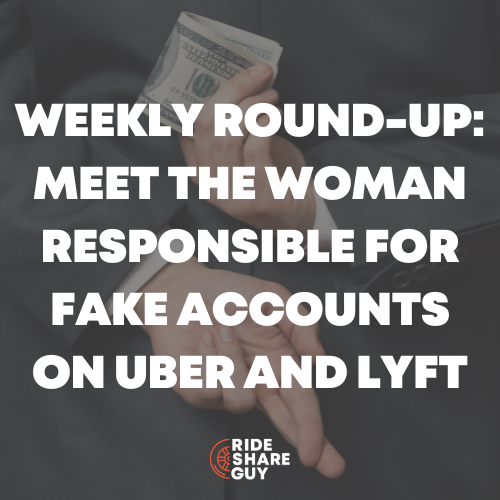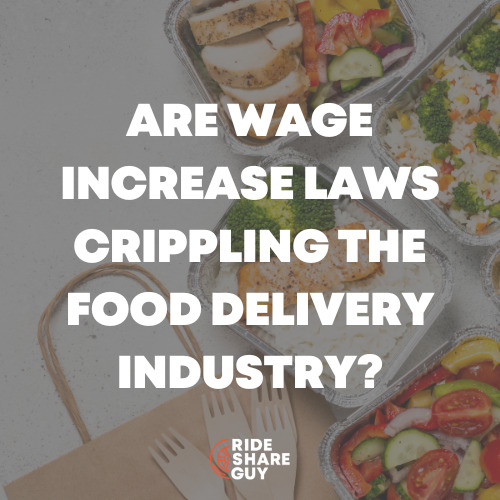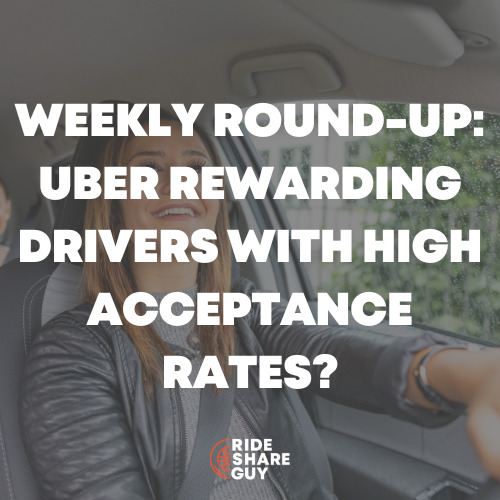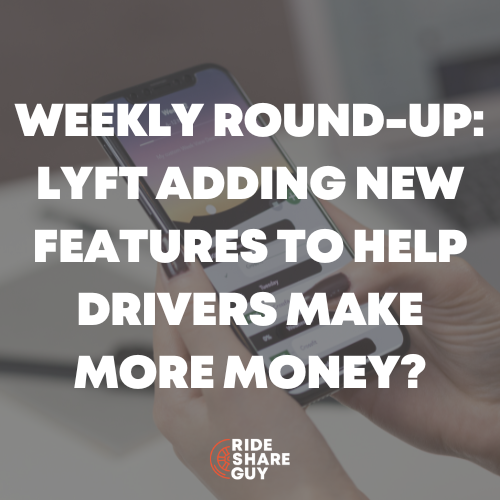Harry here. A lot of reporters were on vacation this week, but Sidecar conveniently decided to announce they were done with rideshare and delivery and we wrote about it here.
Most of the talk this week among drivers though had to do with NYE since, unlike last year, NYE 2016 was very profitable for many drivers. We had a ton of great threads going on over on the RSG Facebook page, and some of the top drivers earned over $1,000 in a single night.

Today, RSG contributor John Ince takes a look at the rest of the stories from the week though: Sidecar’s downfall, a passenger rating guide and more.
How to Be a Five-Star Uber or Lyft Passenger
Sum and Substance: You probably check your Uber and Lyft drivers’ ratings before you hop in their car, but those drivers pay attention to your rating as well. And a bad rating can make grabbing a ride a lot harder in the future. To keep your passenger rating as high as possible, you need to know what drivers look for in passengers, too.
You can save yourself and your driver a lot of headache with just a little forethought before you call your ride. When you are ready to set your pickup location, think about things from the driver’s point of view. They can’t safely stop in the middle of a super busy street, especially during a really busy time of day.
Michael Morales, a driver for Lyft, explains at The Bold Italic that they’re not taxis with their own lanes, or taxi stands for pickups. Morales suggests you walk around the corner and choose a location that will avoid a possible accident or ticket. It’s easier for the driver, and it gives you a way to get into the vehicle safely.Stand near a place they can pull off the road, or take a quick stroll to a side street if you can. It’s also good idea to wait until you’re ready to go before you summon your ride.
My Take: Most of these are common sense, but in the modern world common sense is becoming increasingly uncommon. For example, how often have you arrived at the passenger pickup location at a busy intersection and see no one there and no place to legally wait. Why can’t passenger figure this out?
This chart shows how Uber is devastating New York’s taxi business
Sum and Substance: Uber’s devastating effect on the New York cab industry is plain to see in this chart, produced by Goldman Sachs, showing the change in the price of New York City taxi medallions since 2004. New York’s yellow taxicabs are the only vehicles in the city allowed to pick up passengers who hail them from the street.
The medallion system, in place since 1937, sets an upper limit on the number of those cabs. As demand grew, medallions became more and more valuable. This chart shows how medallion prices rose from about $250,000 in January 2004 to a peak of just over $1 million for an individual medallion — and about $1.3 million for a corporate one — in March 2013. But starting in 2010, Uber’s drivers — who aren’t allowed to accept street hails — started filling this government-created vacuum.
As Uber added more and more drivers, medallion priced stagnated, then started to fall precipitously. The more people hail cars through Uber, the less money cab drivers make, and the worse taxi medallions look as an investment. One of the city’s largest taxi companies, White & Blue Group, saw its monthly medallion-leasing income drop as much as 50 percent in the past year, according to a lawsuit it filed against the city last month.
My Take: This is the real cost to the taxis in the Uber wars – the declining value of the medallions. It was predictable, but it’s nevertheless kind of shocking how quickly and how precipitously their value took a dive. But who knows – with a favorable decision in legal disputes and with the arrival of the Flywheel app to better compete on technology, maybe the value of medallions will make a comeback.
Google Wants to Use its Self-Driving Cars to Take On Uber and Lyft
Sum and Substance: For the last several years, Google has been putting a lot of work into developing its self-driving cars. What exactly the search engine giant intended to do with that technology hasn’t always been clear, but it looks like it will be spinning off its self-driving car division into a separate company sometime next year.
Bloomberg reports that a company insider has revealed that Google will be creating a self-driving car company under its Alphabet Inc. corporate umbrella that will challenge ride sharing ride-sharing startups like Uber and Lyft. Initially, its services would only be offered in confined areas like college campuses or on military bases, but eventually it would expand to public roads.
Uber is already working on a way to replace its drivers with autonomous technology, but this is the first clear indication of how Google plans to make money off of its self-driving cars. It will likely be years before state regulations allow fully autonomous taxis to operate freely on public roads without direct supervision, but starting on college campuses and in office parks would give Google the opportunity to continue developing its technology in small, somewhat more controlled environments.
My Take: Seems like a smart move for Google. They can test out the self-driving cars in a relatively safe, controlled and legal environment, while also testing out a potential new market opportunity in ridesharing. Remember they’ve also got a potential Uber killer coming online too through their Waze subsidiary in Tel Aviv. It enables carpooling and limits drivers to a few rides per day potentially avoiding the legal hassles that Uber has now. Those Google guys are smart!
Waze Could Be Google’s Ace in the Hole in a Self-Driving Car War With Uber
Sum and Substance: It’s 2025. You’re in a big city and have somewhere to be. Fire up an app and an autonomous car — with a driver at the wheel or maybe without one — picks you up. Odds are good the company behind that car will be Uber or Google. The two are set to vie for the reigning position as the transit service platform of the future.
Uber has advantages — for one, its name is becoming the verb for ride-hailing, the way Google’s has for search. But Google has the mobile platform, the lead in self-driving tech and deeper pockets. It has another edge: Deep ties with local governments, critical players in making autonomous vehicles a reality.
This proximity is thanks to Waze, the mapping startup Google bought in 2013, which has invested heavily in building data-sharing agreements with cities around the world. These agreements do not impact government relationships with Google proper, according to Waze (although the team remains part of Google in the Alphabet companies). And the present relationship has nothing to do with autonomous driving. But the agreements have laid the groundwork for deeper ties for a day when self-driving cars come to market.
If autonomous cars are going to work, there needs to be tight coordination of transit data between governments and private companies. Before you can hail a self-driving car, there’ll likely need to be a host of things (designated lanes, re-zonings, ordinances) that let it drive itself. Then there is the planning to ensure they drive effectively. That’s why Google has cut data deals with its flagship mapping product, and why Uber is scrambling to build similar programs.
Waze is, from what we can tell, ahead. In its program, called the Connected Citizens Program, Waze hands over info reported by its users, like accidents and road closures, to urban governments free of charge. It has cut deals with 51 cities worldwide; they get fresh data from the app’s users every two minutes.
My Take: Google has all kinds of data that can be of great value to the company as it seeks to negotiate deals to pave the way for driverless cars. Data may be Google’s ultimate force in the looming transit wars – stay tuned for the sequel due for release sometime in the near future.
Uber driver accused of attacking 2 customers with ice scraper
Sum and Substance: Kourtney Wilson and Toni Sanders left the Winter WonderFest at Navy Pier on Tuesday evening to discover their car had been towed. That was just the beginning of a bad night that would end with Wilson and Sanders scuffling with an Uber driver wielding an ice scraper, according to the two women and police.
“Never did I think that he was going to attack us in the middle of, you know, downtown Chicago during rush hour,” Wilson, 29, said by phone Wednesday. But the driver, Chieh Wang, 37, denied attacking her, though he did acknowledge having an argument. “I will explain to the judge in the court,” he said.
Wilson said she and her friend requested an Uber ride around 6 p.m. after discovering their rental car gone. The two ducked into a Whole Foods at 255 E. Grand Ave., then Wilson went outside to meet the driver while Sanders, 32, was getting rung up. But Wang was already starting to pull away in his Toyota Prius, Wilson said. She chased after it and knocked on the trunk. The car stopped, Wilson got inside and Wang started to leave again, she said. Wilson said she asked Wang to wait for her friend, but he became “very agitated and didn’t want to wait.”
Wilson got out of the car and started to head back to Whole Foods. She said Wang left his car and asked if she wanted to fight him. She said she walked away and asked for another Uber ride. Wilson and Sanders went around the corner to wait for the new driver, and Wang drove away, she said. But moments later, Wang returned, pulled up next to them and stepped out, Wilson said. She said she took out her phone. “I started filming him because there was no reason for him to be pulling up again.” She said Wang took an ice scraper out of his trunk, cursed and started hitting her and Sanders with it. Bystanders stepped in, telling Wang to stop, and called 911, she said.
My Take: This is part of new subcategory of road rage media stories that we might call Rideshare Rage. With all the stresses that rideshare drivers put up with and the passengers who seem to have no clue about inconveniences they’re causing, it’s little wonder that some small percentage of drivers lash out. In this case, the weapon was an ice scraper, which isn’t sharp enough to do any real damage, but the entire incident will surely cost the driver his job and possibly a fair chunk of change in court settlements. Again, one might reasonably ask: is this gig really worth the hassles?
Sidecar Is The Latest Casualty In The Lyft Vs. Uber Ridesharing App War
Sum and Substance: RIP Sidecar. Unfortunately, the news about the end of Sidecar isn’t too surprising. The intense competition between Uber and China’s Didi Kuaidi, who now has a partnership with Lyft, has taken over the ridesharing industry. With no breathing room, smaller car hailing companies like Sidecar, are often left climbing uphill.
Sidecar tried to fight off Uber and Lyft with its business delivery service, but it seems those efforts weren’t enough. In a letter published on Medium, co-founders of Sidecar Sunil Paul and Jahan Khanna announced the service will officially shut down Dec. 31. “Today is a turning point for Sidecar as we prepare to end our ride and delivery service so we can work on strategic alternatives and lay the groundwork for the next big thing,” the letter stated. The co-founders note they have “significant capital disadvantage” but still managed to be an innovation leader in ridesharing, “continually rolling out new products that set the bar for others to follow.”
Sidecar has reportedly raised about $30-35 million in funding according to CrunchBase, chump change compared to Uber and even Lyft. According to the NY Times in October, Uber is set to raise $1 billion in new venture capital. CrunchBase reports Uber has raised $6.6 billion and Lyft $1.2 billion in fundraising.
Driver choice is what sets Sidecar apart. Drivers and riders had more control of the price of each ride depending on distance, type of vehicle and duration of ride. After entering your pickup address and destination (yes, end address was required), a list of all available drivers would appear and you could choose your preference. Maybe you wanted to be picked up in a 2014 Lexus for $20 or a 2008 Camry for $10. There was no algorithm-based surge pricing. If the driver wanted to charge more during rush hour they had the option, but other drivers could lower their prices to attract riders.
My Take: Sidecar had many innovations and looks like their ultimate first is to be the first of the ridehailing companies to go belly up. Kind of a shame because their app had many of the things that drivers would want from Uber but just can seem to get – more control, more ability to determine fares …. but unfortunately they had less of what really matters most – paying passengers.
Uber Announces Its Newest Product – UberFool
Sum and Substance: https://youtu.be/sU89LonCnxQ
My Take: Another wickedly funny video that any drivers who hate UberPool will love.
Drivers, what do you think of the top news stories of the week?
-John @ RSG




